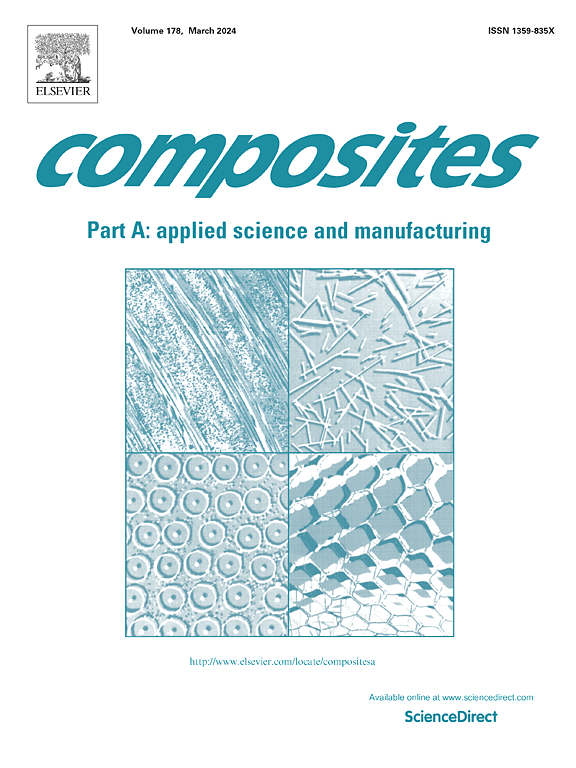先进的连续束剪切工艺,利用纤维转向的在线束宽控制
IF 8.1
2区 材料科学
Q1 ENGINEERING, MANUFACTURING
Composites Part A: Applied Science and Manufacturing
Pub Date : 2025-05-11
DOI:10.1016/j.compositesa.2025.109025
引用次数: 0
摘要
尽管自动纤维放置(AFP)是航空航天工业中最先进的复合材料制造技术之一,但由于其利用纤维束的面内弯曲变形的原理,它在纤维转向方面存在严重的局限性。连续纤维束剪切(CTS)工艺利用纤维束的面内剪切变形有效地解决了纤维转向缺陷。然而,特别是当在具有复杂几何形状的工具上生产分层时,AFP和CTS工艺都可能产生几何缺陷,因为使用有限宽度的胶带无法完美地镶嵌工具表面。这些缺陷会显著降低复合材料的结构性能。为了消除转向缺陷和几何缺陷,本文开发了一种新的拖缆宽度控制(TWiC)机制。这种机制允许在不切割纤维的情况下实时控制纤维束的横截面长径比,同时保持恒定的纤维体积分数。将TWiC装置集成到连续剪切(CTS)过程中,并对其可行性进行了实验研究。为了评估这种先进的CTS (ACTS)工艺的转向质量和精度,使用AFP和CTS工艺铺设相同的纤维路径,并通过光学和激光扫描方法进行比较。结果表明,与AFP和CTS相比,ACTS叠层产生的叠层缺陷明显减少。本文章由计算机程序翻译,如有差异,请以英文原文为准。
Advanced continuous tow shearing process utilising in-line tow width control in fibre steering
Although automated fibre placement (AFP) is one of the most advanced composite manufacturing technologies in the aerospace industry, it has critical limitations in fibre steering due to its principle of utilising the in-plane bending deformation of the tow. The Continuous Tow Shearing (CTS) process has effectively addressed fibre-steering defects by utilising the in-plane shear deformation of the tow. However, particularly when producing layups over a tool with complex geometry, both the AFP and CTS processes can generate geometry-induced defects, as the tool surface cannot be perfectly tessellated using finite-width tapes. These defects may significantly reduce the structural performance of the composite.
To eliminate both steering- and geometry-induced defects, a novel Tow Width Control (TWiC) mechanism was developed in this work. This mechanism allows for on-the-fly control of the tow’s cross-sectional aspect ratio without cutting fibres while maintaining a constant fibre volume fraction. The TWiC device was integrated into the Continuous Tow Shearing (CTS) process and its feasibility was experimentally investigated. To assess the steering quality and accuracy of this Advanced CTS (ACTS) process, the same fibre paths were laid using AFP and CTS processes and compared through optical and laser scanning methods. It was shown that the ACTS layup produces significantly less layup defects compared to AFP and CTS.
求助全文
通过发布文献求助,成功后即可免费获取论文全文。
去求助
来源期刊

Composites Part A: Applied Science and Manufacturing
工程技术-材料科学:复合
CiteScore
15.20
自引率
5.70%
发文量
492
审稿时长
30 days
期刊介绍:
Composites Part A: Applied Science and Manufacturing is a comprehensive journal that publishes original research papers, review articles, case studies, short communications, and letters covering various aspects of composite materials science and technology. This includes fibrous and particulate reinforcements in polymeric, metallic, and ceramic matrices, as well as 'natural' composites like wood and biological materials. The journal addresses topics such as properties, design, and manufacture of reinforcing fibers and particles, novel architectures and concepts, multifunctional composites, advancements in fabrication and processing, manufacturing science, process modeling, experimental mechanics, microstructural characterization, interfaces, prediction and measurement of mechanical, physical, and chemical behavior, and performance in service. Additionally, articles on economic and commercial aspects, design, and case studies are welcomed. All submissions undergo rigorous peer review to ensure they contribute significantly and innovatively, maintaining high standards for content and presentation. The editorial team aims to expedite the review process for prompt publication.
 求助内容:
求助内容: 应助结果提醒方式:
应助结果提醒方式:


